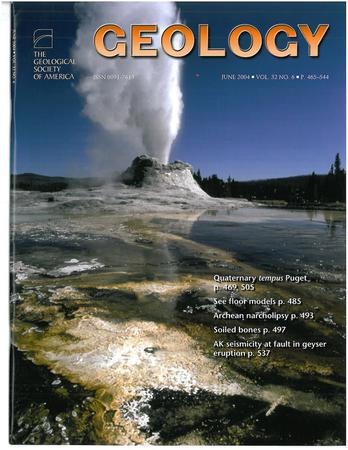Pleistocene Sunda Shelf submersion-exposure cycles initiate vegetation Walker Circulation feedback
IF 4.8
1区 地球科学
Q1 GEOLOGY
引用次数: 0
Abstract
Recent research has found that the subsiding Sunda Shelf (Southeast Asia) was permanently exposed prior to ca. 400 ka with initial submersion-exposure cyclicity, associated with interglacial-glacial sea-level cycles, beginning between 400 and 240 ka. We analyzed the impact submersion-exposure cycles on regional environment and climate through a 640 k.y. leaf-wax carbon isotope (δ13Cwax) reconstruction at Andaman Sea Site U1448, representing relative changes in C3/C4 plant abundances. Prior to ca. 250 ka, the Sunda region was inhabited by a stable C3 (forest) biome, after which submersion-exposure cycles initiated with the deglacial sea-level rise at ca. 250 ka. During subsequent glacial-age sea-level drops, the newly exposed shelf was rapidly colonized by C4 grasses, followed by slow transitions back to C3 forests, representing a tenfold increase in the variability of C3/C4 vegetation in the Sunda region. The C3/C4 regime shift since 250 ka is coherent across the Southeast (SE) Asia peninsula and Sunda Shelf and is coincident with a shift in the east-west sea-surface temperature gradient in the equatorial Pacific Ocean. We hypothesize that the expansion of C4 grasslands promoted and sustained drier glacial-age climates over SE Asia via a feedback mechanism that contributed to weakening the ascending branch of the east-west atmospheric circulation in the equatorial Pacific region known as the Walker Circulation. Our results indicate that the Sunda Shelf region has a larger influence on Walker Circulation than is seen in current paleoclimate simulations.更新世巽他大陆架浸没暴露循环启动植被Walker环流反馈
最近的研究发现,下沉的巽他大陆架(东南亚)在约400 ka之前就已经永久暴露,最初的浸没暴露周期性与间冰川海平面周期有关,始于400至240 ka之间。我们通过在安达曼海U1448进行640 k.y.叶蜡碳同位素(δ13Cwax)重建,分析了浸没暴露周期对区域环境和气候的影响,代表了C3/C4植物丰度的相对变化。在约250 ka之前,巽他地区居住着稳定的C3(森林)生物群落,之后随着约250 ka的冰川消退海平面上升,开始了淹没暴露周期。在随后的冰川期海平面下降期间,新暴露的大陆架被C4草迅速定植,随后缓慢过渡回C3森林,这意味着巽他地区C3/C4植被的变异性增加了十倍。自250 ka以来,C3/C4模式的变化在东南亚半岛和巽他大陆架是一致的,与赤道太平洋东西向海面温度梯度的变化相一致。我们假设C4草原的扩张通过一种反馈机制促进并维持了东南亚更干燥的冰川期气候,这种反馈机制有助于削弱赤道太平洋地区东西向大气环流的上升分支,即沃克环流。我们的结果表明,巽他大陆架区域对沃克环流的影响比当前古气候模拟中看到的更大。
本文章由计算机程序翻译,如有差异,请以英文原文为准。
求助全文
约1分钟内获得全文
求助全文
来源期刊

Geology
地学-地质学
CiteScore
10.00
自引率
3.40%
发文量
228
审稿时长
6.2 months
期刊介绍:
Published since 1973, Geology features rapid publication of about 23 refereed short (four-page) papers each month. Articles cover all earth-science disciplines and include new investigations and provocative topics. Professional geologists and university-level students in the earth sciences use this widely read journal to keep up with scientific research trends. The online forum section facilitates author-reader dialog. Includes color and occasional large-format illustrations on oversized loose inserts.
 求助内容:
求助内容: 应助结果提醒方式:
应助结果提醒方式:


